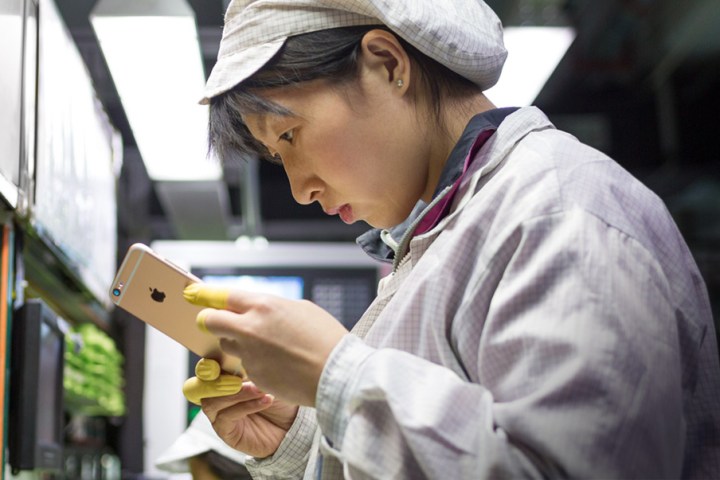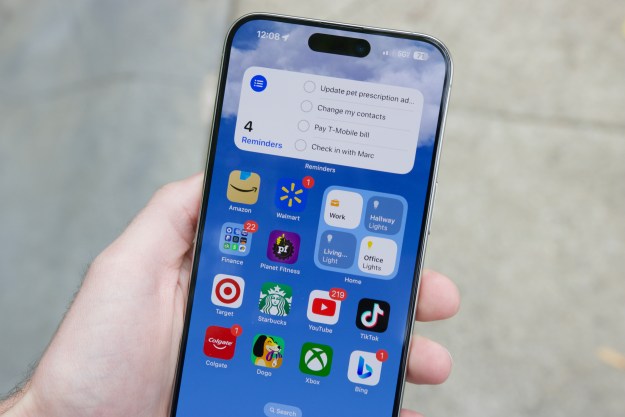
Electronics maker Foxconn, one of Apple’s largest suppliers, confirmed on Sunday that it was mulling a $7 billion investment to create a flat-panel manufacturing facility in the United States, Reuters reported. This would bring one of the major components in smartphones to American shores and would be an important step toward building iPhones in the U.S. Founder and chairman Terry Gou said the move may create as many as 50,000 jobs and would involve Japanese subsidiary Sharp; talks were reportedly underway in Pennsylvania and in other states.
Rumors swirl about “Made in the USA”
Speculation on Apple’s plans began in late 2016, and heightened following an interview with Donald Trump in The New York Times, during which he recounted a phone conversation with Tim Cook urging the CEO to move part of Apple’s production line to the U.S.:
“I was honored yesterday, I got a call from Bill Gates, great call, we had a great conversation, I got a call from Tim Cook at Apple, and I said, ‘Tim, you know one of the things that will be a real achievement for me is when I get Apple to build a big plant in the United States, or many big plants in the United States, where instead of going to China, and going to Vietnam, and going to the places that you go to, you’re making your product right here.’ He said, ‘I understand that.’ I said: ‘I think we’ll create the incentives for you, and I think you’re going to do it. We’re going for a very large tax cut for corporations, which you’ll be happy about.’”
Trump has spoken on a number of occasions since about Apple moving production to the U.S. Days before his inauguration, the president-elect spoke with Axios, saying that Cook had his “eyes open to it” and that he thinks Cook “loves this country, and I think he’d like to do something major here.”
Such a move may become more feasible given Foxconn’s plans. The company first confirmed that it was exploring investing in the U.S. in early December: “We are in preliminary discussions regarding a potential investment that would represent an expansion of our current U.S. operations,” Foxconn said to CNNMoney.
Softbank CEO Masayoshi Son met with Trump shortly after to announce a planned $50 billion investment in U.S. startups. The CEO held a paper with Softbank’s and Foxconn’s name, along with the following text: “commit to: Invest $50bn + $7bn in US, generate 50k + 50k new jobs in US in next 4 years.” That led to speculation that Foxconn would have a role in bringing jobs to the U.S.
“While the scope of the potential investment has not been determined, we will announce the details of any plans following the completion of direct discussions between our leadership and the relevant U.S. officials,” the manufacturer told CNNMoney.
Trump is a vocal supporter of U.S. companies that build their products in the U.S. and has proposed levying steep tariffs — potentially as high as 45 percent — on competing Chinese importers.
Nikkei, citing a source familiar with Apple’s plans, reports that the Cupertino, California-based company has tasked Foxconn and Pegatron, the two tech firms responsible for assembling more than 200 million of Apple’s iPhones annually, with investigating the feasibility of building plants in the U.S.
“We’re going to get Apple to build their damn computers and things in this country instead of other countries,” Trump said in a speech in January. “How does it help us when they make it in China?”
Pegatron reportedly demurred, citing logistical concerns. Foxconn agreed to compile a report as soon as June, but company chairman Terry Gou warned that it would show drastically higher productions costs. The potential result? An iPhone made in the U.S. could retail for as much as $740 to $1,300 for a 32GB iPhone 7 versus $650 today, according to Nikkei.
Apple has previously declined to move iPhones production stateside, citing costs.
Question: Would you pay $80 more for your next iPhone if you knew it was Made in the USA?
— Jeremy Kaplan (@SmashDawg) November 18, 2016
What would a U.S.-made iPhone cost?
A thorough report in the MIT Technology Review found that moving iPhone assembly to the U.S. would add $30 to $40 to the cost of an iPhone thanks to “transportation and logistics expenses [that] would arise from shipping parts.”
Manufacturing the smartphone’s hundreds of components domestically is an even pricier — and vastly more complex — proposition. Apple Chief Executive Tim Cook told CBS’ 60 Minutes in December 2015 that the U.S. labor pool lacked the skills necessary to carry out iPhone production, and Apple executives have estimated that it would take as long as nine months to recruit the roughly 8,700 industrial engineers that oversee Chinese assembly lines. And that’s before efficiency is taken into account: A 2012 CNN Money report noted that Chinese factories house workers in employee dormitories and “can send hundreds of thousands to the assembly lines at a moment’s notice.”
Then there’s the U.S.’s lack of natural resources to consider. MIT Technology Review points out that few of the 75 elements required to manufacture the iPhone are available commercially in the U.S. Aluminum, for instance, requires bauxite, and there are no bauxite mines in the U.S. China, on the other hand, produces 85 percent of the world’s rare earth metals.
Further complicating matters is Apple’s sprawling supply chain of more than 750 firms in over 20 countries. Taiwan Semiconductor produces crucial iPhone chips; South Korea’s SK Hynix and Japan’s Toshiba produce the handset’s memory modules, and Japan’s Japan Display and Sharp provide the iPhone’s display. “To make iPhones, there will need to be a cluster of suppliers in the same place, which the U.S. does not have at the moment,” an industry executive familiar with iPhone production told economics blog NorthCrane.
But Apple’s plan isn’t without precedent. In 2013, Motorola Mobility employed more than 3,800 employees to assemble the Moto X, a flagship Android phone, at a factory in Fort Worth, Texas. Just a year later, though, it was forced to shutter production as a result of “exceptionally tough” market conditions, according to Motorola president Rick Osterloh. The company subsequently moved production to China.
Others have been more successful. Foxconn established a stateside iMac computer assembly line in 2012. A year later, Singapore-based Flextronics, the manufacturer of Apple’s Mac Pro desktop computer, built a production line in Austin, Texas.
In October 2015, Sharp president Tai Jeng-wu suggested that if Apple were to begin producing smartphones in the United States, it would likely follow suit. “We are now building a new [advanced organic light-emitting diode] facility in Japan. We can make [OLED panels] in the U.S. too,” he said. “If our key customer demands us to manufacture in the U.S., is it possible for us not to do so?”
Geopolitical implications
China’s reaction to any effort to move iPhone manufacturing to the U.S. could be severe. In an opinion piece published in a state-backed newspaper, the Chinese government warned of retaliatory measures if such trade restrictions were to go into effect. “A batch of Boeing orders will be replaced by Airbus. U.S. auto and iPhone sales in China will suffer a setback, and U.S. soybean and maize imports will be halted. China can also limit the number of Chinese students studying in the U.S.,” a Global Times article read.

A move of production by Apple could also threaten the company’s relationship with Chinese leadership. Earlier this year, in what was widely seen as a protectionist move by regulators, Apple’s iBooks and iMovies were temporarily blocked within the country. And in June, China’s Beijing-based intellectual Property Office found that Apple’s iPhone 6 and iPhone 6 Plus infringed on a design patent held by Chinese company Shenzhen Baili.
Apple has extended olive branches in recent months. The company invested $1 billion in China-based ride-sharing app Didi Chuxing. It’ll open its first research and development facility in the country — a $45 million office within Beijing’s Zhongguancun Science Park — by the end of this year. And in October, it pledged to build a second facility in China’s Shenzhen province.
Even if Apple were to move iPhone production to the U.S., it likely wouldn’t be enough to stem the country’s losses. Foxconn employed roughly 690,000 workers in China as of the end of April, down slightly from a peak of 1.3 million in 2012. The Economic Policy Institute, a U.S. think tank, estimated that the U.S. had lost five million manufacturing jobs between 2000 and 2014.
But politics may trump economics in the end. U.S. automaker Ford may prove the precursor of developments to come: The company shelved plans to move production of its Lincoln crossover SUV from Kentucky to Mexico. “The Apple supply chain must treat Trump’s campaign pledge seriously and not write it off,” an industry executive told NorthCrane.
Article originally published in November 2016. Updated on 01-23-2017 by Jeremy Kaplan: Added details from Foxconn event about potential $7 billion U.S. investment.
Editors' Recommendations
- iPhone 16: news, rumored price, release date, and more
- This new folding phone costs less than half the price of the iPhone 15 Pro Max
- This is our best look yet at the iPhone 16’s big design changes
- This could be our first look at iOS 18’s huge redesign
- Apple’s new iPad Pro and iPad Air just got delayed



